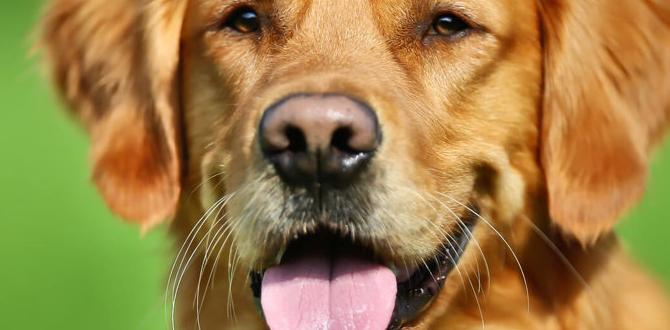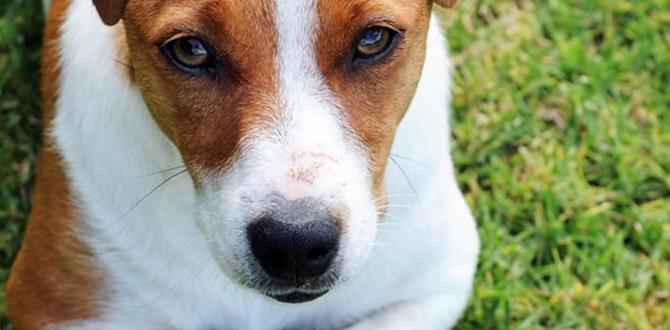Every dog has a unique personality, just like people do. Some dogs are outgoing and friendly, while others can be shy or reactive. If you have a reactive dog, you may wonder how to help them feel more comfortable.
Picture this: You’re on a walk, and your dog suddenly barks at another dog. It’s startling, right? Many dog owners face this same challenge. This is where learning how to desensitize a reactive dog becomes important. By understanding their triggers, you can help them feel calm and safe.
Did you know that many reactive dogs are just scared? They react because they don’t know how to handle certain situations. By teaching them how to stay calm, you can change their behavior. Imagine a world where your dog walks peacefully beside you!
In this article, we’ll explore effective methods to desensitize your reactive dog. You’ll find useful tips and fun activities. Get ready to build your bond with your furry friend while creating a peaceful walking experience!
How To Desensitize Reactive Dog: Effective Training Techniques

How to Desensitize a Reactive Dog
Desensitizing a reactive dog takes patience and understanding. Start by identifying what triggers your dog. Gradually expose them to these triggers at a distance where they feel safe. Use treats to create positive associations. Are you worried your dog may never calm down? Remember, every small step counts. Consistency is key! Fun fact: Many dogs show improvement in just a few weeks with the right approach. With time, your dog can become more relaxed and confident!Understanding Reactive Behavior
Definition of dog reactivity. Common triggers for reactive behavior.Reactive behavior in dogs means they react strongly to certain things. These reactions can be loud barking, lunging, or growling. It often comes from fear. Common triggers include:
- Strange people
- Other dogs
- Group crowds
- Loud noises
- Fast movements
Understanding what triggers your dog can help reduce these strong reactions. This awareness is the first step to better behavior.
What causes a dog to become reactive?
Many things can cause reactivity, such as past trauma, lack of socialization, or feeling threatened. Knowing these causes helps owners manage their dog’s behavior better. Each dog is unique and may react differently based on their experiences.
Identifying Your Dog’s Triggers
How to observe and note triggers. Importance of knowing your dog’s body language.Many dogs get jumpy about certain things. To help your dog, you need to find out what makes them react. Start by watching your dog closely. Look for signs like tail wagging or stiff body. Take notes. This helps you see patterns. Noticing these triggers is like solving a mystery—“Who let the dogs out? Oh wait, it was that lawnmower!”
Understanding your dog’s body language is important, too. A wagging tail might mean happiness, but if it’s low and fast, your dog might be scared. Keep a diary of these signs. It can really help you create a plan to make your pup feel safe.
| Body Language Signs | Meanings |
|---|---|
| Tail Up | Happy |
| Tail Between Legs | Fearful |
| Stiff Body | Alert |
Creating a Safe and Controlled Environment
Setting up a training area. Managing interactions with other dogs and people.Training your reactive dog starts with creating a comfy training zone. Choose a quiet space with no distractions. Think of it as a doggie classroom, but without the bored students! Limit their time with other dogs and people to avoid overwhelming them. Keep their interactions short and positive. Use treats as easy “peace offerings.” A table can help visualize this:
| Setting | Tip |
|---|---|
| Home | Choose a quiet room for training. |
| Outdoors | Know your dog’s comfort zone. Maintain distance from other dogs. |
With patience and these easy steps, you’ll help your furry friend feel safer and more relaxed!
Desensitization Techniques
Gradual exposure strategies. Use of distance and controlled encounters.Desensitization helps dogs feel calm and safe around triggers. One way is through gradual exposure. Start by showing your dog the trigger from far away. Over time, decrease the distance, but only if your dog stays relaxed. Controlled encounters can also help. Use a leash and a calm friend or another dog during practice. This helps your dog learn to act well in real situations. Remember, patience is key!
How can I safely expose my dog to triggers?
Begin with small distances. Gradually bring your dog closer as they become comfortable. Use treats and praise to reward them for staying calm. Controlled settings allow for safe practice without overwhelming them.
Tips for Gradual Exposure:
- Start far away from the trigger.
- Use calm body language.
- Reward good behavior consistently.
Counter-Conditioning Methods
Positive reinforcement approaches. Examples of rewarding desired behaviors.Dog training can be fun! To help a reactive pup, use positive reinforcement. This means rewarding good behavior. When your dog stays calm, give them a treat or lots of praise. It’s their version of winning a gold medal! Check out the table below for examples:
| Situation | Desired Behavior | Reward |
|---|---|---|
| Seeing another dog | Staying calm | Favorite treat |
| Walking past a loud noise | Not reacting | Praise and a belly rub |
| Meeting new people | Sniffing happily | New toy |
With a little patience, your dog will learn to be calm and happy! Remember, training is like a game—keep it fun!
Building a Solid Foundation of Basic Commands
Importance of obedience training. Key commands that help in reactive situations.Training your dog in basic commands is key. It builds trust and helps with issues like barking or jumping. Commands like sit, stay, and come are very useful. They can help calm your dog during reactive moments. Here are some important commands:
- Sit – This helps control your dog’s excitement.
- Stay – Keeps your dog in one spot.
- Come – Ensures your dog returns to you quickly.
Obedience training can change your dog’s behavior. Remember, patience is essential. The more you practice, the more comfortable your dog will become in different situations.
Why is obedience training important?
Obedience training makes your dog safer and happier. It allows them to follow directions and feel less stressed.
Utilizing Professional Guidance
When to seek help from trainers or behaviorists. Benefits of group classes and socialization opportunities.Sometimes, help from trainers or behaviorists is the best step. If your dog acts scared or aggressive, a professional can guide you. They know how to read dog behavior. They can teach you effective methods to calm your dog. Group classes offer great benefits. Here are a few:
- Learn in a safe environment.
- Meet other dogs and owners.
- Practice social skills together.
These experiences are helpful. They can make your dog feel more comfortable around others.
When should you seek help from trainers or behaviorists?
Seek help if your dog shows strong reactions. Seek help whenever you notice signs of fear or aggression. Early intervention can prevent problems down the line.
What are the benefits of group classes and socialization opportunities?
Group classes are useful for learning and growth. They provide a safe space for your dog to socialize. Your dog will meet other dogs, improving confidence and behaviors.
Implementing Consistency in Training
Setting a routine for training sessions. Importance of family involvement in the training process.Creating a steady schedule for training helps dogs learn better. Try to set aside the same time each day for practice. This routine can include fun exercises and social time. Family involvement is also key. Everyone in the household should help with training. This shows consistency and reinforces good behavior. Happy dogs respond well when many people join in their training.
- Choose a regular training time.
- Involve family members in sessions.
- Make training fun and engaging.
Why is family involvement important in dog training?
Family members can provide support and different perspectives. This makes learning easier for your dog. Plus, it builds a strong bond between your dog and everyone in the home.
Measuring Progress and Adjusting Techniques
How to track behavioral improvements. Knowing when to modify your approach.Tracking how your dog is reacting can be fun and informative! Use a journal or an app to note improvements. Look for changes in their behavior, like less barking or relaxing around other dogs. Celebrate those little wins—they count! When your pup seems to stall, it might be time to tweak your methods. Maybe a new treat or a different spot to practice could help. Remember, patience and flexibility are key!
| Behavior Change | Date Noted | Notes on Technique |
|---|---|---|
| Less barking around other dogs | 01/15 | Used treats and praise |
| Calmed down during walks | 01/20 | Tried shorter routes |
Potential Challenges and Solutions
Common obstacles faced during desensitization. Strategies for overcoming setbacks in training.Desensitizing a reactive dog can be tough. Some common challenges include fear, distractions, or a lack of focus. Dogs may also feel overwhelmed, making progress slow. Here are some strategies to help:
- Break training into small steps.
- Be patient and keep sessions short.
- Use rewards for calm behavior.
- Minimize distractions in your surroundings.
- Practice regularly to build confidence.
Each dog is unique. Celebrate small victories. Remember, consistency leads to success!
What are common obstacles in dog desensitization?
Obstacles include fear, distractions, and quicker setbacks that may happen. Dogs can feel overwhelmed or distracted by their environment. Recognizing these challenges helps in better planning for training sessions.
Conclusion
In summary, desensitizing a reactive dog takes patience and practice. Start with slow introductions to triggers. Use positive reinforcement to reward calm behavior. Consistency is key, so stick to your training routine. Remember, every dog is different, and progress may take time. For more tips, consider reading training guides or joining a dog training class. You can do this!FAQs
What Are The Most Effective Techniques For Gradually Desensitizing A Reactive Dog To Specific Triggers?To help a reactive dog, we can use a method called desensitization. First, you need to find out what worries your dog. Then, you should expose your dog to that trigger slowly and from a distance. Give your dog treats or praise when they stay calm. Gradually get closer as your dog becomes more comfortable. Always be patient and take your time!
How Can I Identify My Dog’S Triggers To Create A Tailored Desensitization Plan?To find your dog’s triggers, watch how they act in different situations. Note what makes them scared, excited, or nervous. Keep a journal to track things like loud noises, other animals, or certain people. You can use this list to make a plan to help them feel better over time. Start slow and stay positive!
What Role Does Positive Reinforcement Play In The Desensitization Process For Reactive Dogs?Positive reinforcement helps reactive dogs feel safer and happier. When you reward your dog with treats or praise for calm behavior, they learn to stay relaxed. This makes them less scared of things that usually bother them, like other dogs or loud noises. Over time, your dog starts to feel more comfortable and confident. So, positive reinforcement makes training easier and more fun!
How Long Should I Expect The Desensitization Process To Take, And What Signs Indicate Progress?The desensitization process can take a few weeks to several months. It depends on you and what you are facing. Signs of progress include feeling less scared, doing things you avoided, or feeling calmer. You might notice you can handle the situation better each time. Remember, everyone moves at their own speed!
Are There Specific Tools Or Equipment (Like Muzzles Or Harnesses) That Can Aid In The Desensitization Of Reactive Dogs During Training Sessions?Yes, there are tools that can help. A muzzle keeps other people and pets safe while you train your dog. A harness can give you better control. There are also calming vests that help your dog feel more relaxed. These tools make training easier and safer for everyone.
Meet Elyse Colburn, the devoted canine companion and storyteller behind the enchanting world of “Tales, Tails, and Adventures Unleashed.” A passionate dog enthusiast with a heart full of paw prints, Elyse Colburn shares heartwarming tales and insightful adventures, celebrating the joy, loyalty, and endless antics that make every dog a true hero. Join Elyse Colburn on this tail-wagging journey, where every post is a love letter to our four-legged friends.







